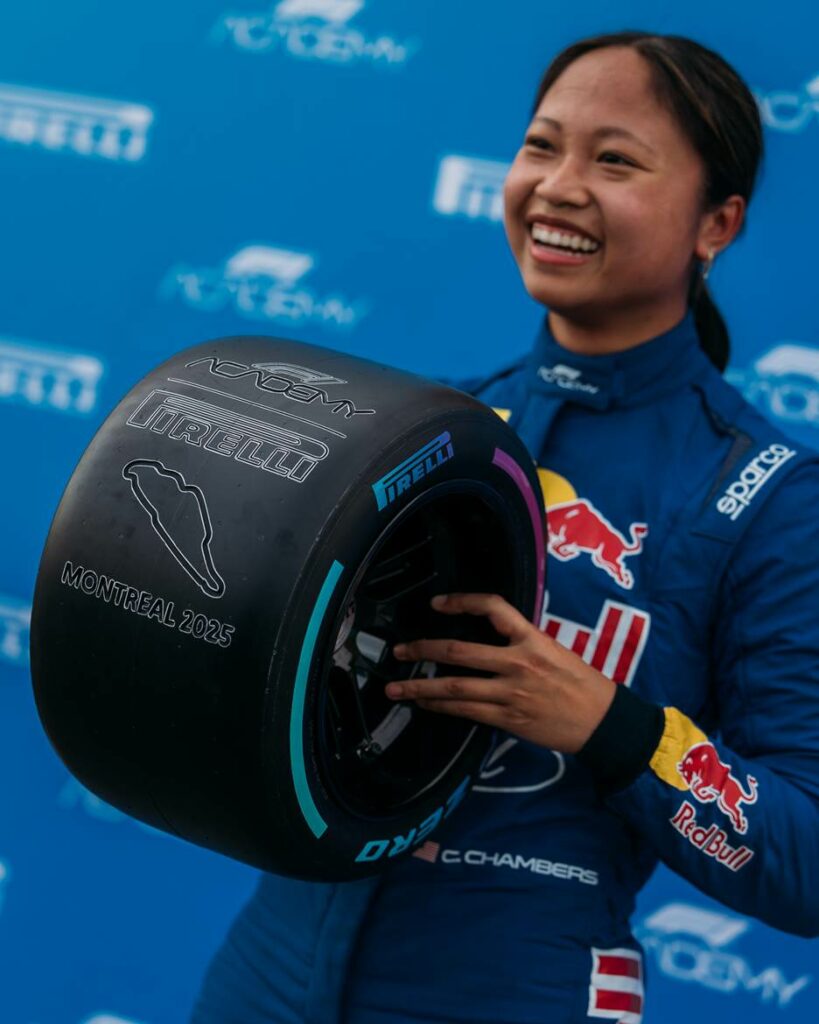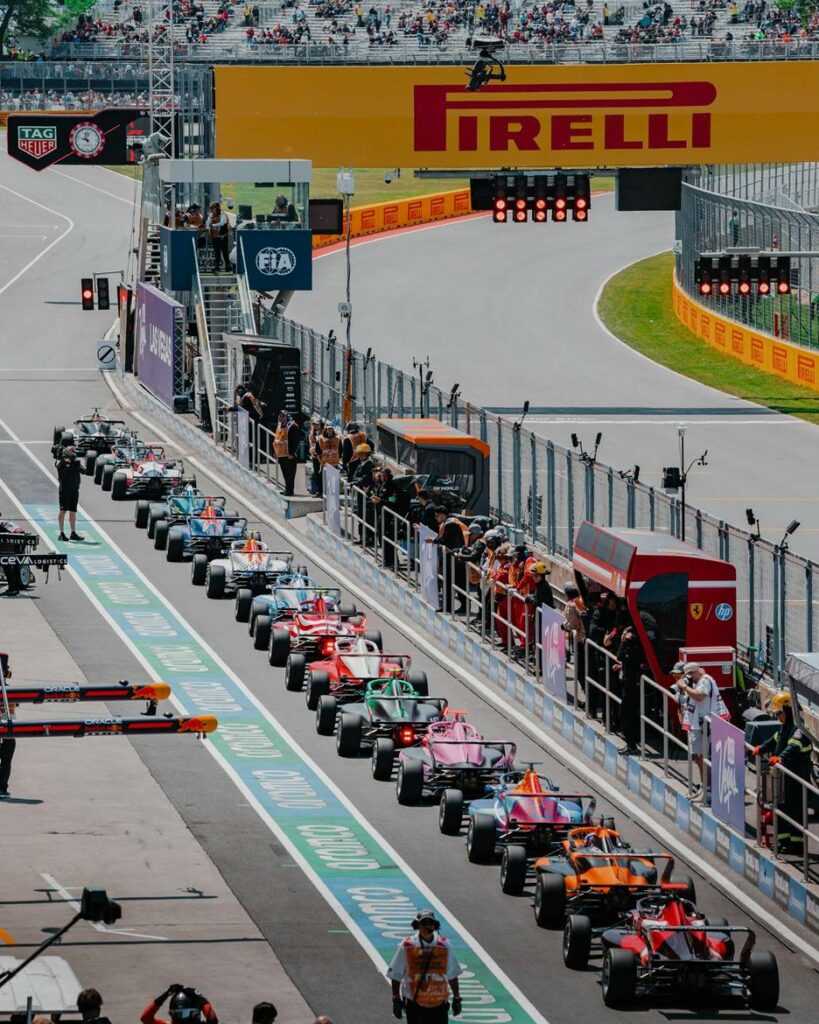The first four rounds of the 2025 F1 Academy season have revealed a championship defined not by anecdotes or dramatic storylines but by pure statistical reality. Doriane Pin of Prema Racing with the supprt of Mercedes-AMG Petronas F1 Team, commands the standings with 109 points, establishing a clear benchmark of competitive strength. Her strong form across Race 1 and Race 2 events has created a buffer that directly pressures every rival, ensuring that rivals must produce exceptional performances merely to remain in contention.
Chloe Chambers, driving for Campos Racing with Red Bull Ford backing, trails Pin by 20 points. Despite the gap, she retains a mathematical pathway to the championship. Maya Weug of MP Motorsport, with Scuderia Ferrari HP support, lies 37 points behind, while Ella Lloyd of Rodin Motorsport with the support of McLaren Racing, is 42 points adrift. The arithmetic makes it evident that these four drivers form the core group capable of influencing the title outcome. All others in the field retain only theoretical possibilities, contingent upon near-perfect weekends and significant underperformance by the front-runners.
Understanding the 2025 F1 Academy Championship requires careful attention to statistical distributions, weekend averages, and performance across both races. Pin’s weekend average of 27.25 points denotes her advantage, underpinned by a remarkable Race 2 average of 20.50 points and consistent Race 1 returns of 6.75 points. These figures establish a threshold that rivals must either surpass or depend on a drop in Pin’s performance to overcome.

Retrospective analysis: Race 1 and Race 2 patterns
A detailed review of the first four rounds demonstrates that Race 2 events have served as the primary differentiator between contenders. Pin’s Race 2 scores—26 points in Shanghai, 15 in Jeddah, 25 in Montreal Race 1, and 16 in Montreal Race 3—highlight a level of dominance that extends beyond her raw totals. While her Race 1 results are more modest, they provide a steady collection of points, stabilising her weekend averages and reinforcing her overall lead. Maintaining a weekend average of 27.25 points puts Pin as the benchmark for the rest of the 2025 F1 Academy championship.
Race 1 results challenge Championship fight
Chloe Chambers exhibits a contrasting performance pattern. Her Race 2 average of 18 points keeps her mathematically viable, yet her Race 1 returns of 4.25 points limit her capacity to outscore Pin without perfect execution. To mount a credible challenge, Chambers must preserve her Race 2 efficiency while enhancing her Race 1 outcomes, transforming the shorter races into opportunities for cumulative point gains.
Maya Weug and Ella Lloyd display similar dualities. Weug’s Race 1 average of 4.75 points combined with a Race 2 average of 13.25 points places her in a highly sensitive position relative to Pin’s consistency. Lloyd’s Race 1 average of 5.25 and Race 2 average of 11.50 points create a comparable constraint: she must extract maximum points in the higher-value Race 2 events while elevating Race 1 scoring to maintain statistical plausibility.

Large deficits keep threats to Top 4 theoretical
The gap separating these top four drivers from the remainder of the grid underscores the importance of consistent performance. Alisha Palmowski and Alba Hurup Larsen, with deficits of 56 and 63 points respectively, fall within a purely mathematical window. Tina Hausmann, Nina Gademan, and Emma Felbermayr occupy a middle band of sporadic scoring, whereas drivers including Lia Block, Chloe Chong, Rafael Ferreira, Aurelia Nobels, Aiva Anagnostiadis, Joanne Ciconte, Nicole Havrda, and Courtney Crone remain largely theoretical threats. Their potential influence depends on simultaneous perfection and misfortune at the front.
Mathematical pathways: Championship scenarios
With three weekends remaining, the arithmetic governing the 2025 F1 Academy Championship becomes explicit. Each driver must outscore Pin by at least their current deficit plus one point across the remaining 117 points available. Translating this into minimum per-weekend gains—expressed as deficit plus one divided by three—provides a clear benchmark against Pin’s 27.25-point weekend average.
Pin’s strategy is simple and self-sufficient. Maintaining her current weekend output forces all rivals into scenarios requiring near-perfection. Consistency, rather than risk-taking, represents her optimal approach; minor errors create opportunities predominantly for the nearest challenger, Chloe Chambers.

A steep challenge
Chambers’ challenge is significant but possible. To overturn a 20-point deficit, she must average approximately 34.25 points per weekend if Pin maintains 27.25 points. This is below the 39-point maximum achievable per weekend, indicating that a championship reversal remains possible, although highly demanding. Chambers must elevate her modest Race 1 average of 4.25 points, preserve or improve her Race 2 output of 18.00 points, and exploit opportunities for pole positions and fastest laps. Pin’s Race 2 dominance remains the stabilising factor, requiring precise execution from the challenger.
Weug, 37 points adrift, confronts an even steeper challenge. Even with maximum weekend points of 39, she requires Pin’s output to fall below 26.33 points per weekend to retain a realistic statistical chance. Lloyd, 42 points behind, faces a narrower corridor: she must maximise her points while Pin averages below 24.67 points per weekend. Both scenarios underscore the dual dependency on personal elevation and front-runner regression, highlighting the low probability of success despite theoretical viability.
Further down, Palmowski and Larsen, trailing by 56 and 63 points, remain mathematically alive only if both perfect performance and dramatic decline from the leaders coincide. For them, and the remainder of the field, the path to the 2025 F1 Academy Championship is virtually closed under standard competitive conditions.

Pressure points for the final three rounds of the season
Analysing each of the remaining weekends shows the arithmetic pressures that define the title race. Pin’s continued scoring of approximately 27 points per weekend sets a baseline against which rivals’ gains are measured. For Chambers, this requires an additional seven points per weekend relative to Pin. Achieving 34 points while Pin maintains 27, for example, would reduce the deficit from 20 points to 13 points, intensifying the competitive pressure heading into subsequent rounds.
Weug and Lloyd’s potential gains rely on both peak performance and Pin’s regression. A hypothetical 38-point weekend for Weug, paired with an output of 25 points from Pin, would reduce her deficit to 24 points, while a similar performance from Lloyd would decrease her deficit to 27 points. These scenarios remain contingent on underperformance from Pin, showing the fine balance of opportunity, risk, and execution present in the arithmetic framework.
Race 2 emerges as the major factor across all remaining weekends. Its higher point yield, combined with fastest lap bonuses, amplifies the impact of strategy, qualifying, and racecraft. All challengers must maximise Race 2 points, as even small failures in this event could render broader efforts ineffective. Pin’s existing Race 2 supremacy ensures that only near-perfect weekends by challengers such as Chambers are sufficient to materially shift the championship trajectory.
Weekend Averages as the Championship axis
The 2025 F1 Academy Championship is heavily defined by weekend averages, which serve as both indicator and fulcrum. Pin’s overall weekend average of 27.25 points functions as the axis around which all title scenarios revolve. Her Race 2 average of 20.50 points shows her dominance in longer races, creating a consistent gap to rivals, while her Race 1 average of 6.75 points establishes a stabilising baseline. This combination ensures challengers must not only maximise their own performance but also capitalise on even minimal lapses by Pin.
Chambers’ 22.25 points per weekend highlight both potential and constraints. While her Race 2 average of 18 points places her within striking distance, her 4.25 points in Race 1 restrict the ceiling for weekend totals. Consequently, she must pursue all avenues—pole positions, fastest laps, and consistent race finishes—to reduce the points deficit.
Weug and Lloyd are in similar situations. Weug’s weekend average of 18 points and Race 2 average of 13.25 points require personal elevation and simultaneous regression from Pin. Lloyd’s 16.75 points per weekend and 11.50 in Race 2 present a narrow corridor where cumulative gains in both race formats are essential. Across three weekends, even minor differences in averages can generate critical swings, showing the compounded impact of consistent front-running versus chasing.

Midfield and lower-order drivers: Statistical pathways
Outside the top four, midfield and lower-order drivers remain statistically relevant. Tina Hausmann, with 9 points per weekend on average, demonstrates reliable Race 2 results but minimal Race 1 scoring. Elevation in the shorter races is needed to leverage the longer-race performance. Nina Gademan mirrors this profile, with an 8.25-point weekend average and similar dependencies on consistent top-eight finishes.
Emma Felbermayr’s 5.25-point weekend average represents the lowest within this mid-pack, necessitating stringing together reliable points finishes to prevent further erosion. Lia Block, Chloe Chong, and Rafael Ferreira display occassional scoring with rare peaks, such as Block’s 12-point Montreal Race 1 effort. To remain statistically relevant, they must optimise Race 1 opportunities while maintaining Race 2 performance.
At the bottom of the field, Aurelia Nobels and Aiva Anagnostiadis, each with 5 points and weekend averages of 1.25, face extreme limitations. Joanne Ciconte, Nicole Havrda, and Courtney Crone reflect similarly minimal returns, with Crone yet to score. While mathematical pathways exist, the ceiling is narrow and requires exceptional personal performance coupled with notable regression from leaders.
The maximum Pin averages permitting a theoretical challenge for these drivers reveal the improbability of reversals: Hausmann ≤14.33 points; Gademan ≤13.33; Felbermayr ≤9.33; Block ≤7.33; Chong ≤6.00; Ferreira ≤5.33; Nobels/Anagnostiadis ≤4.00; Ciconte ≤3.67; Havrda ≤2.67; Crone ≤2.33.

Strategic levers and critical metrics
The statistical landscape requires specific strategic priorities. Pin’s advantage lies in consistency and Race 2 dominance; avoiding errors and maintaining around 27.25 points per weekend is paramount. Even minor lapses disproportionately benefit the nearest rival, Chloe Chambers. For Chambers, improvement in Race 1 scoring, conversion of poles, and maximisation of Race 2 points constitute the primary mechanisms to close the 20-point gap.
Weug and Lloyd face dual dependencies: personal elevation and Pin’s regression. Achieving high-30s points in Race 2 and elevating Race 1 outputs are non-negotiable for creating a credible swing. Palmowski and Larsen, off the lead by 56 and 63 points, require extraordinary performance and dramatic front-runner decline to remain mathematically viable.
Midfield and lower-order drivers shift emphasis from championship contention to consistent point accumulation, aiming for repeatable finishes that bolster rankings, team performance, and sponsor metrics. Their role, while unlikely to affect the title, remains strategically important.

Outlook for the remaining three weekends
The arithmetic for the remaining three weekends is explicit. Pin’s stability—maintaining around 27 points per weekend—is sufficient to safeguard the title. Any minor dip could allow Chambers to exploit the margin, but only through near-perfect weekends. Chambers must achieve net gains of roughly seven points per weekend relative to Pin, utilising both Race 1 and Race 2 maximisation alongside pole positions and fastest laps.
Weug and Lloyd require personal peak performance and simultaneous regression from Pin. The broader field depends upon extreme combinations of individual perfection and front-runner underperformance to maintain theoretical relevance. Weekend averages reinforce the competitive axis: Pin 27.25, Chambers 22.25, Weug 18.00, Lloyd 16.75. The compounded effect of these averages across three weekends amplifies every point, qualifying performance, and race result, making the arithmetic the dominant determinant of outcomes.
Numbers define the Champion
After four rounds, the 2025 F1 Academy Championship is defined by statistical precision rather than narrative flair. Pin’s combination of Race 2 dominance, consistent Race 1 scoring, and a 27.25-point weekend average forms a strong framework challenging all rivals to an almost perfect execution. Chambers remains the only realistic contender capable of overtaking Pin without significant front-runner regression, though her pathway demands exceptional performance. Weug and Lloyd retain mathematical possibilities, dependent upon personal elevation and regression from Pin. All other drivers, while technically alive, require extreme conditions to influence outcomes.
As the season advances, every weekend, pole, and fastest lap will notably shape the 2025 F1 Academy Championship. The arithmetic governing the remaining 117 points ensures Pin’s consistency remains central, with rivals maximising every opportunity within a highly compressed points landscape. Ultimately, the numbers are decisive: the championship is Pin’s to lose, Chambers remains the main threat, and the rest of the field must focus on strategic consolidation, performance development, and preparation for future campaigns.





